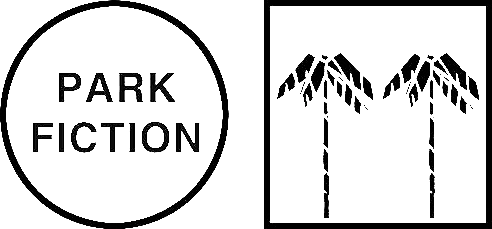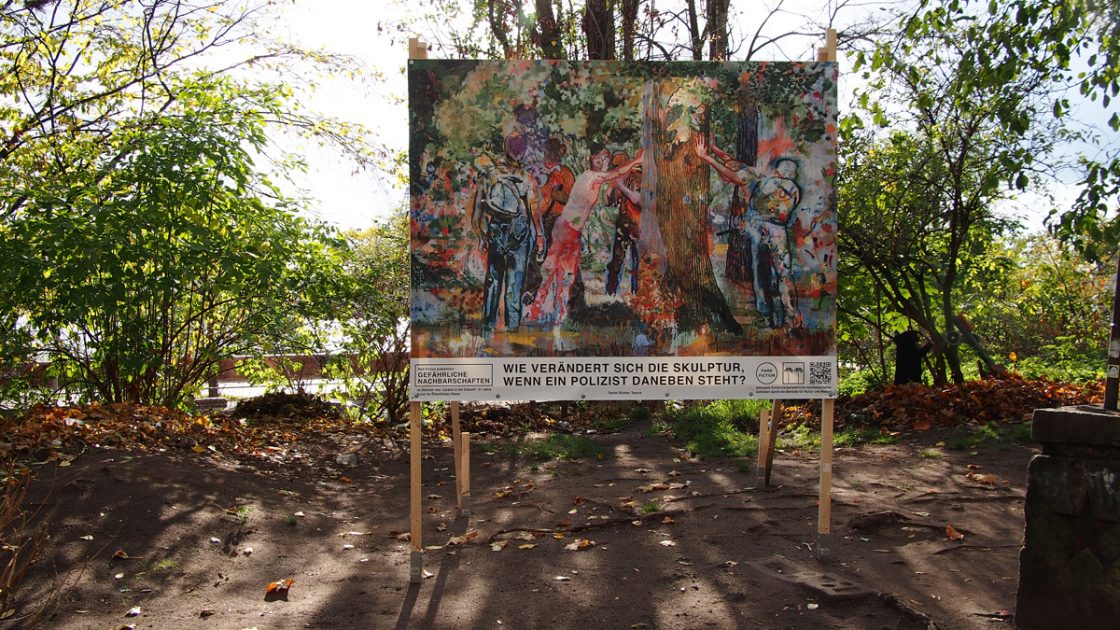Exhibition – Talkshow – Move
„How does a sculpture change when a policeman stands next to it?“ – With this question as a leitmotif, the Park Fiction Committee has invited 17 international artists to develop works for Hamburg’s public space.
From Nov. 2 – 27, all the works will be shown in St. Pauli, around the park, and within the extension of the so-called „danger area“ of January 2014, or the „dangerous place“ of today.
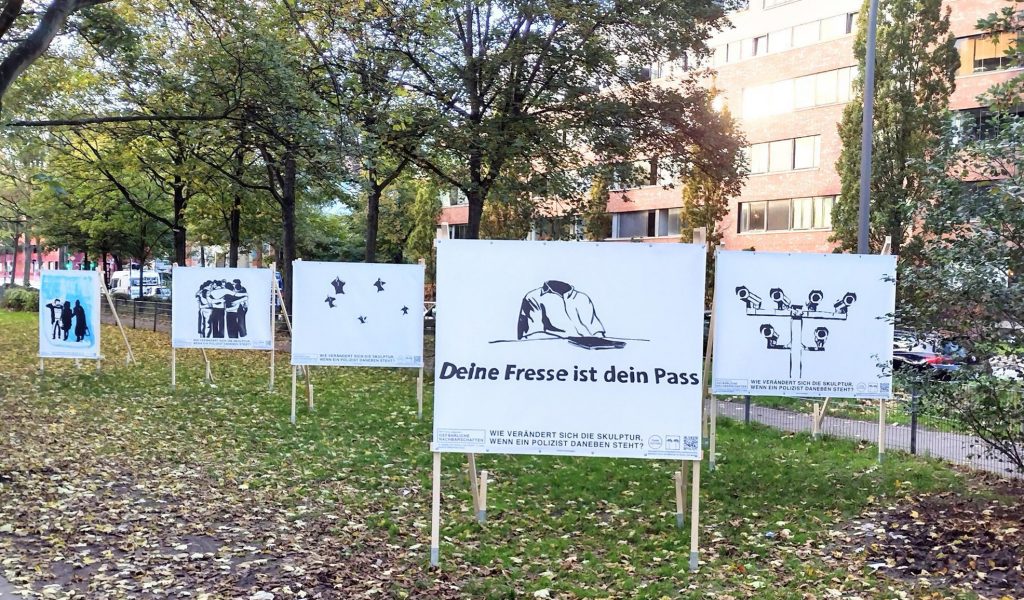
Can art operate in a discursive, legal, political and police confrontational situation?
The Park Fiction Committee thinks art can interfere and it should. Our exhibition tries to put the power of art and the police in relation to each other.
And this exhibition does that with simple means: The latex prints playfully spread across the autumnal green and open spaces, stretched on light wooden scaffolding. Many works use trompe l’oeill effects on site, working multi-faceted layers of meaning out of context.
We show documentary drawing and photography, but also laconic minimal works that, like a stage set, function precisely when something or someone steps beside it. The motifs range from utopian glimpses into the past to dystopian visions of the future, from analyses of police behaviour protocols to painterly reflections of the controlling gaze.
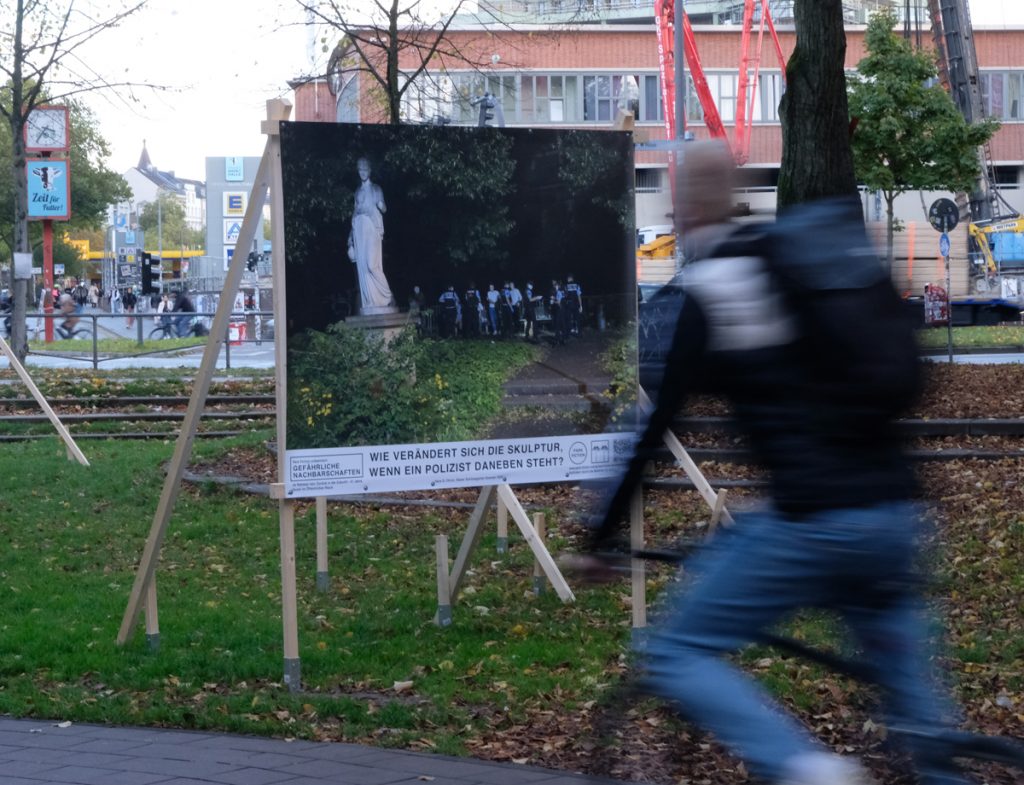
All the pictures, drawings and poems have a stripe that is reminiscent of the warning banderoles on cigarette posters. But instead of warning about the harmful effects of tobacco consumption, they ask about the side effects of police presence.
The project is concerned with the question: What kind of gaze is installed by the police presence? This involves the thought of Althusser, from his book on „Ideological Invocation“. Althusser’s example: When the policeman says „Hey, you there!“, the reaction is completely different from when anyone says „Hey, you there!“. When the policeman says „Hey, you there!“, a submission and a subject is constituted at that moment. Since uniform and appearance are also language, the installation of patrol density and „dangerousness“ narratives does something very similar and fundamental.
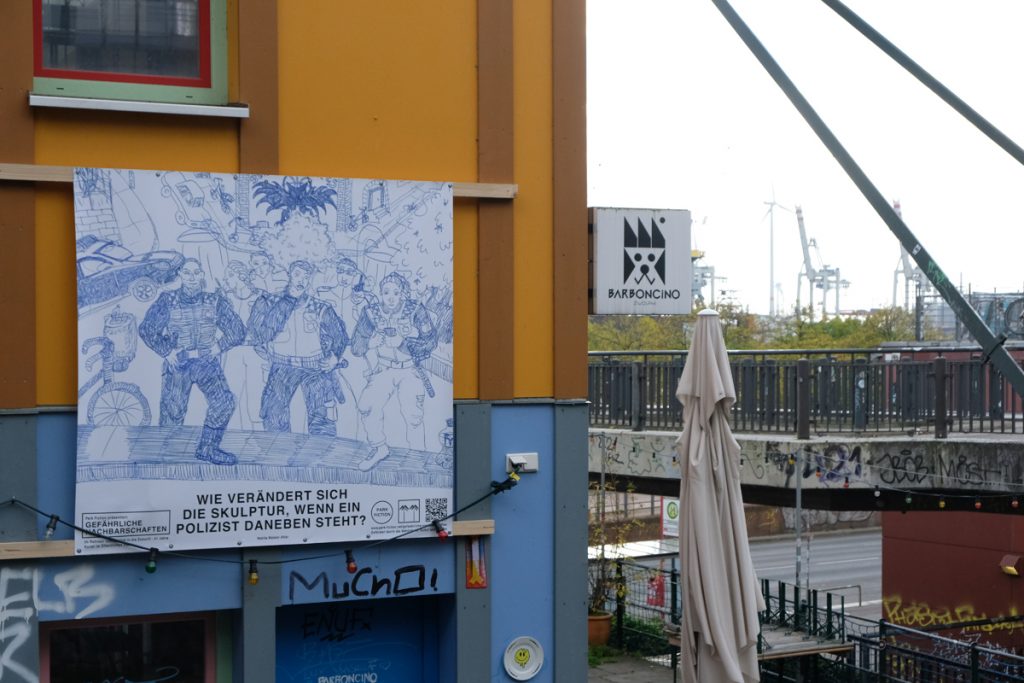
The exhibition spans a dramaturgical arc from Arrivatipark / Neuer Pferdemarkt in the north, to Park Fiction, and all the way to the banks of the river Elbe.

1
Hans D. Christ puts the lighting and anti-corner policy in relation to the excessive control regime in Stuttgart’s Schlossgarten in the summer of 2020. The Stuttgart riots had broken out there after around 300 youths had protested without result against a racist police check. A week later, THW floodlight masts illuminated the entire park. Christ contrasts the classical-mythological setting of white sculptures and opera facades with the white-clad bodies of the policed youths and the black-and-blue figures of the police.
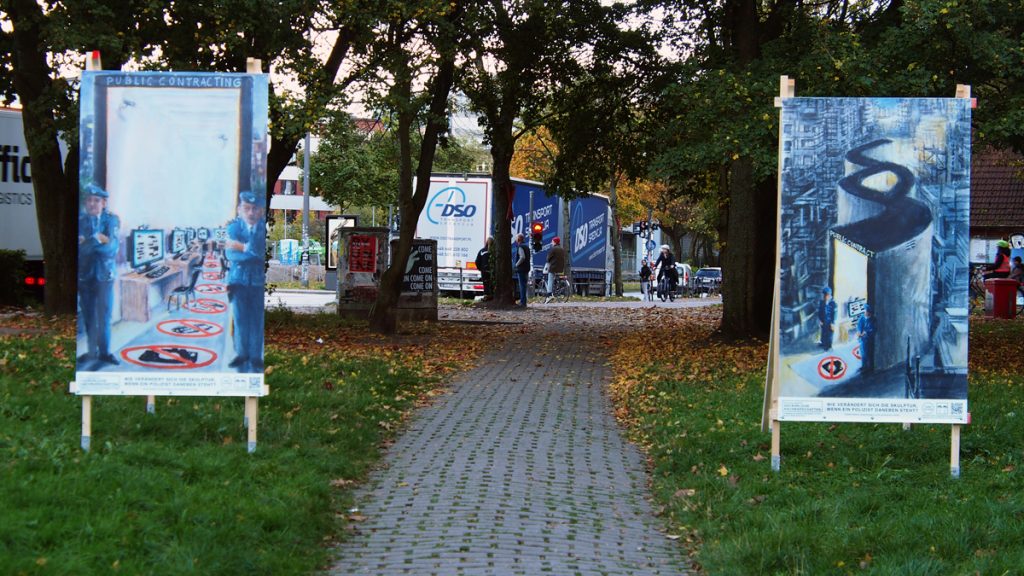
1
Andreas Siekmann answers the question about the impact of the uniformed security gaze with a pair of drawings from the series „Records from the post-factual age“. „Contracts in the Ministry of Economics are sometimes shown for inspection to selected parliamentarians who are not allowed to have a camera, pen or mobile phone with them. Then a stick from the Federal Chancellery is plugged in and, under the supervision of security personnel plus surveillance cameras, the contracts can then be viewed, sometimes blacked out by up to 70%.“ (Siekmann)
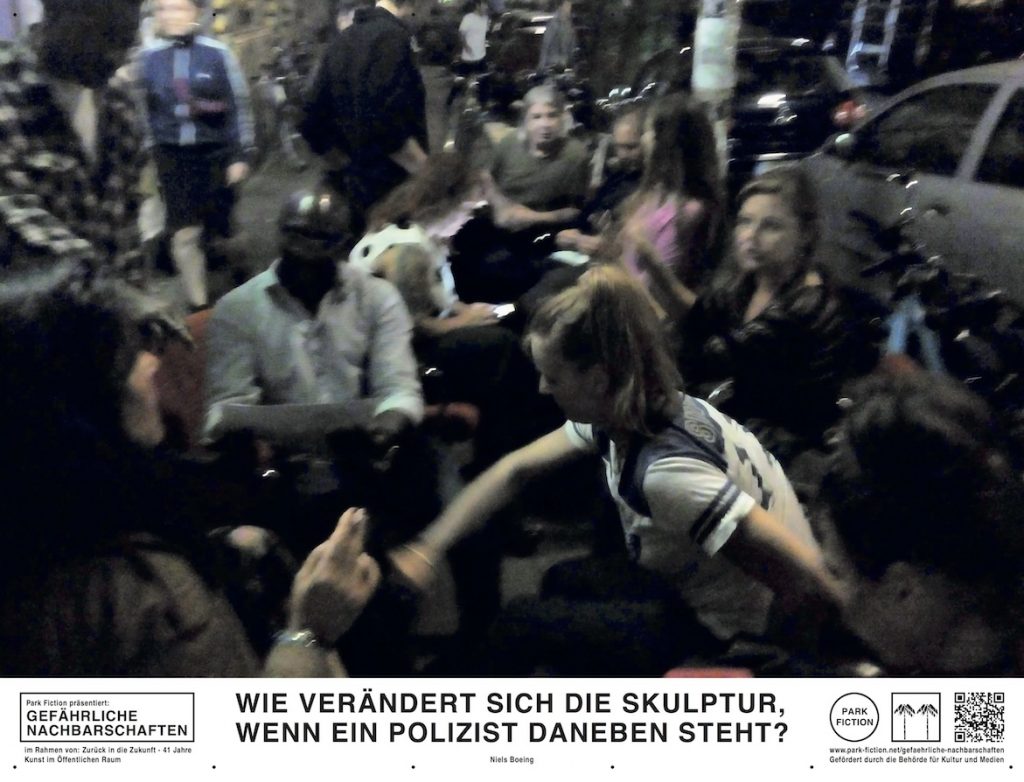
2
Author Niels Boeing recalls the lost informal freedom on the neighbourhood’s nighttime streets with a scene on the street in front of the so-called „district living room“ of the initiative „Wohl oder Übel“. Implicitly, his photo raises the question: „How does the meeting (conversation) change when a policeman stands next to it?“
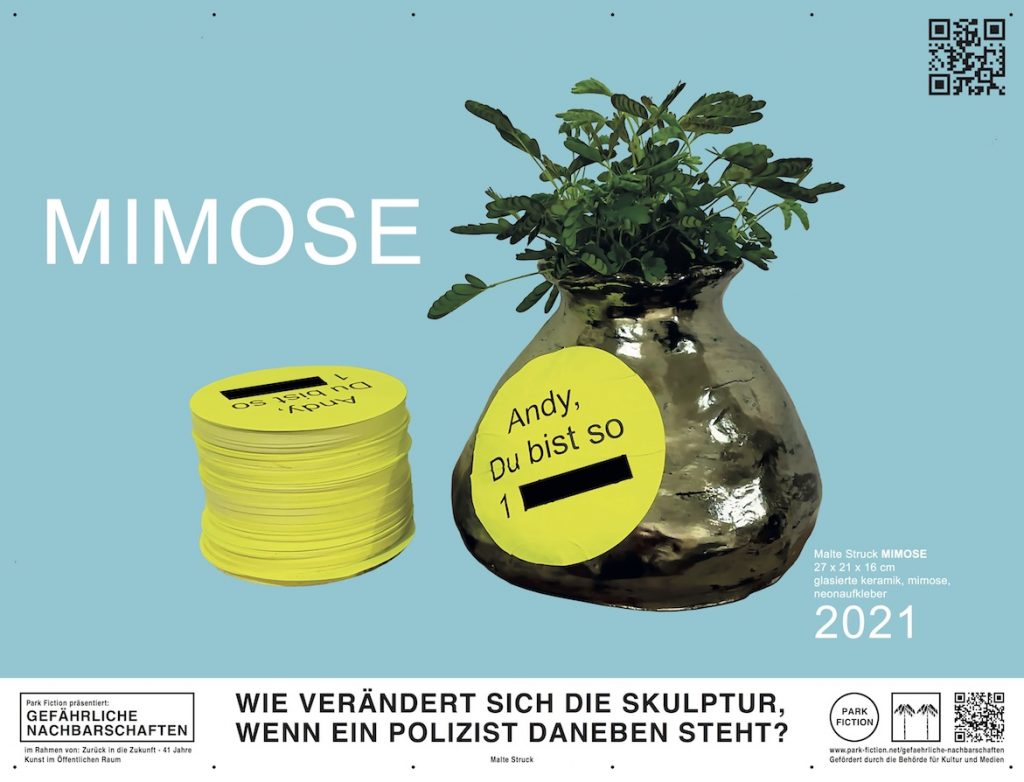
2
Artist Malte Struck interprets the poster series in the style of an advertisement for a ceramic: his flower pot for a mimosa is covered with a neon-coloured sticker, but it does not advertise a special offer, but picks up on that discourse about insult and illegal house searches that made the Hamburg Senator of the Interior famous nationwide. Anyone who picks up the QR code is directed to a video that reenacts the moment of the sticker snatching by the police.
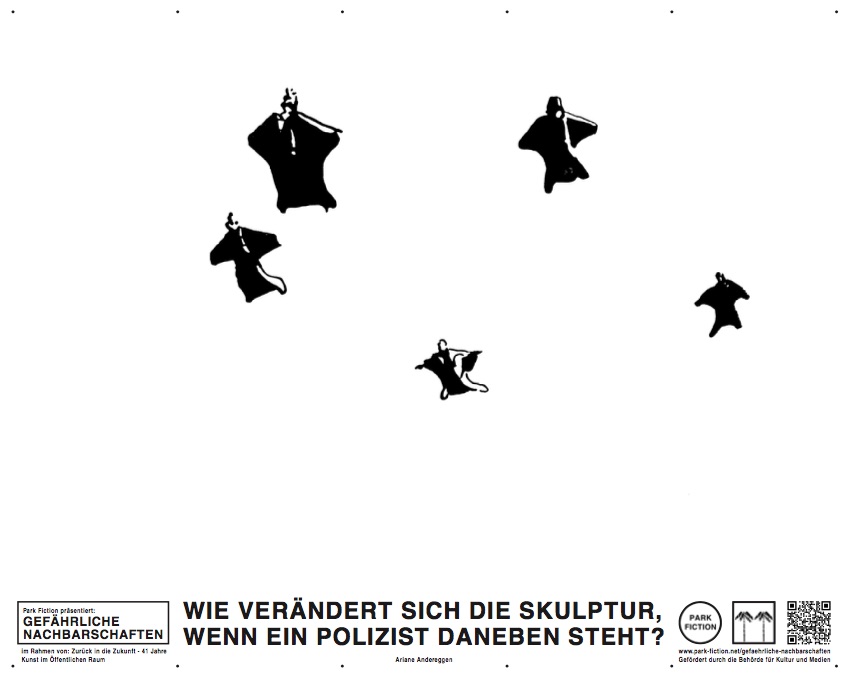
3
In five ingeniously simple ink drawings, Swiss artist and performer Ariane Andereggen relates the exploitation and border regime to the solidarity-based body politics of the precarious, to surveillance, flight and flight fantasies.

4
The Hamburg artist Christoph Schäfer shows a terse scene from everyday life in Sankt Pauli: as a matter of course, two officers of the so-called task force take up the entire width of the pavement, while the residents carrying their shopping bags home just as naturally avoid the encounter by crossing the street between parked cars. What looks banal can also be interpreted as suspicious behaviour in the context of the danger zone.
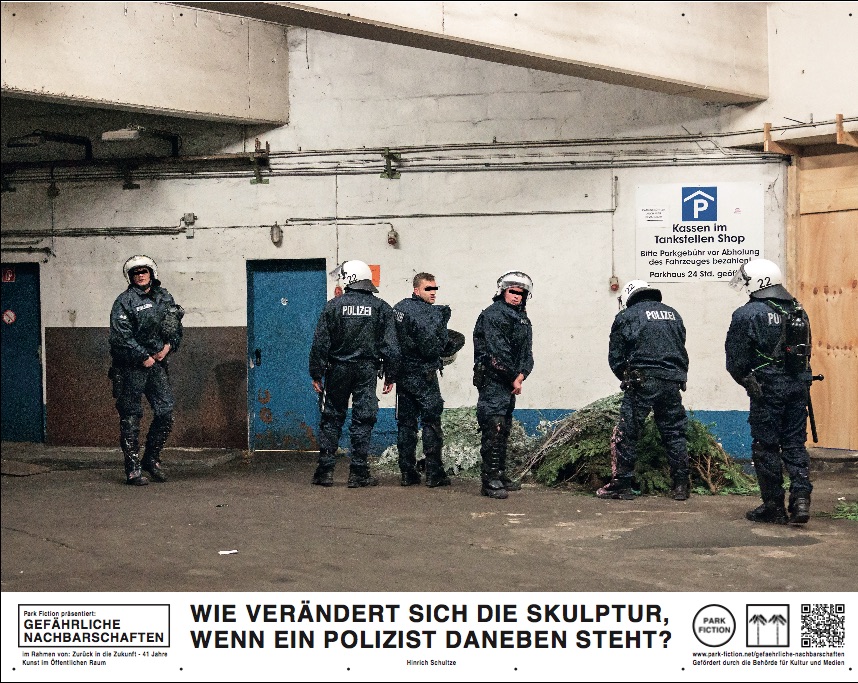
5
Photographer Hinrich Schultze takes a humorous look at a police unit in combat gear, photographed in a somewhat unflattering situation.
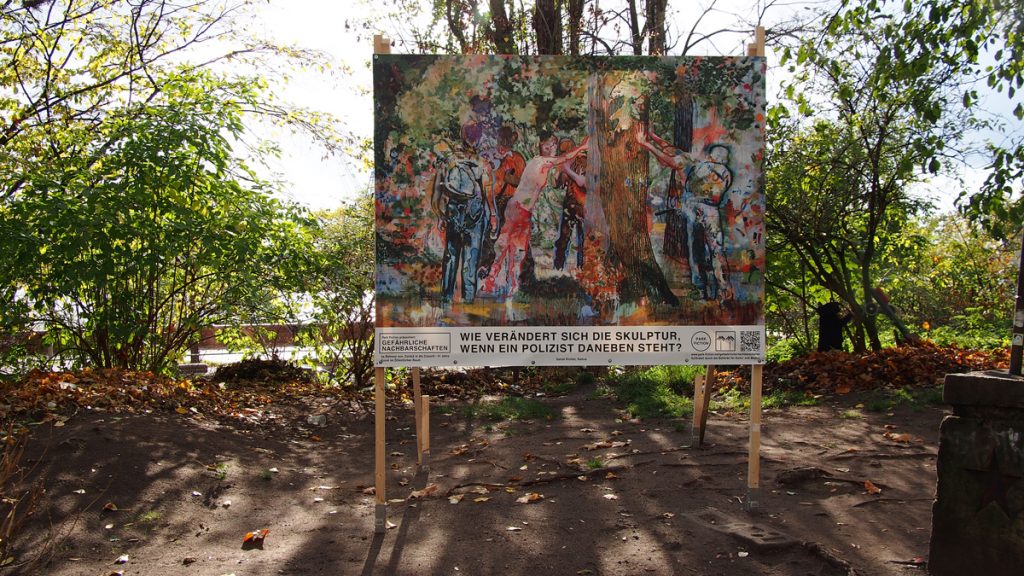
5
Daniel Richter shows a picture from the turn of the millennium. The dissolution of the inner-European borders was accompanied by an initially unnoticed expansion of the border regime to the entire territory, which also characterises the situation around the harbour steps. Richter’s dissolved painting style, a graffiti- and thermal camera-trained post-impressionism, corresponds with the depicted situation of a control of people placed against trees, as it happens more frequently here at the stairs than elsewhere in Germany.
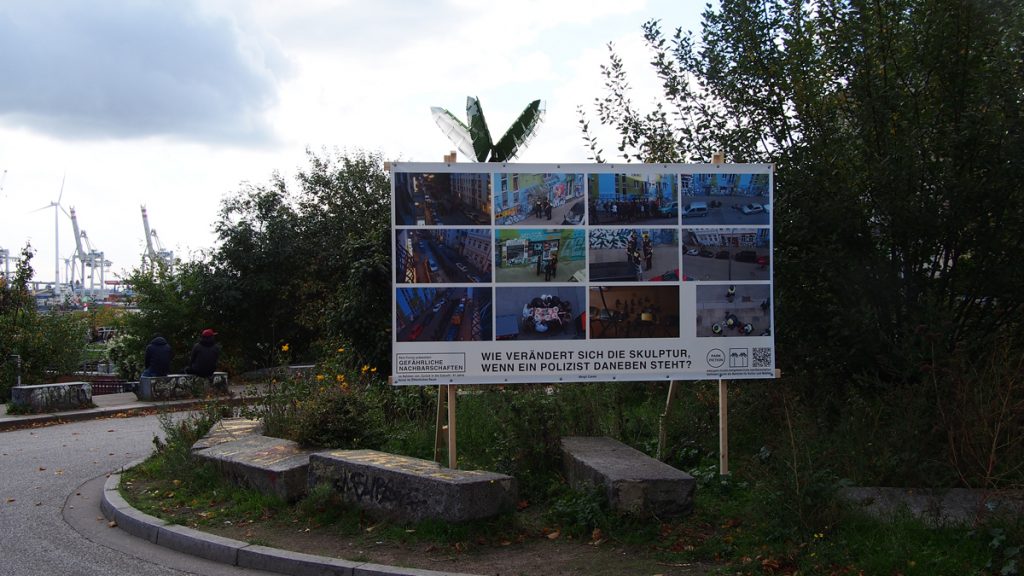
6
Margit Czenki, artist and filmmaker, shows a panorama, photographed exclusively from the perspective of her private balcony. Alongside scenes of neighbourly appropriation of urban space, police constellations dominate the street: rummaging through flower pots, six people meeting for a chat on the pavement, walking in marching order, stopping a black person while putting up posters. And then suddenly a falsely suspected woman is pushed to the pavement. The images elaborate protocols of behaviour that construct an entire neighbourhood as a case of suspicion, quite independently of the mistakes of individuals.
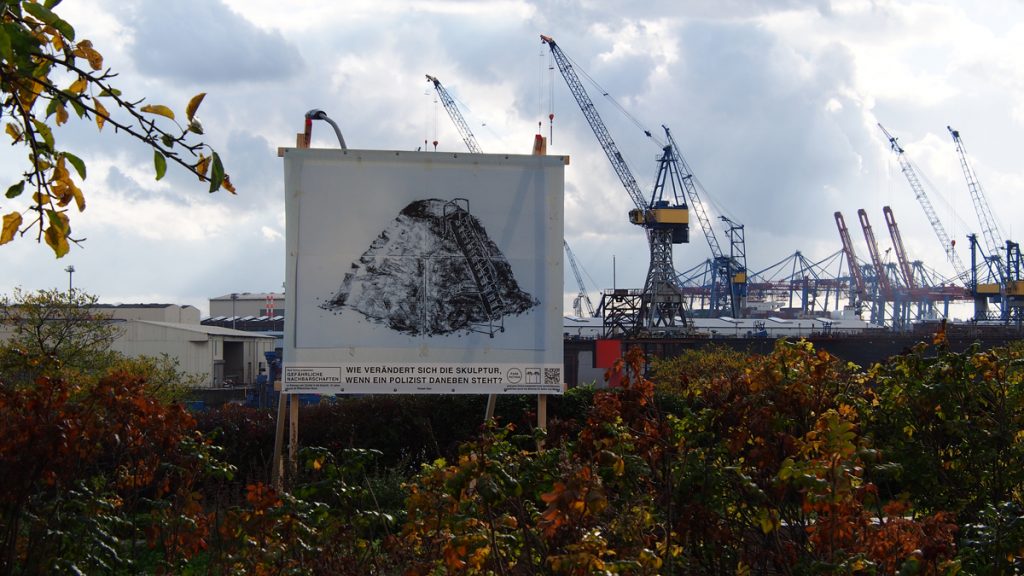
7
Prateek Vijan has simply drawn us a mountain, reminiscent of early minimalist sculptures by Bruce Naumann, or of a film set, i.e. a sculpture waiting to see how it changes when something else joins it.
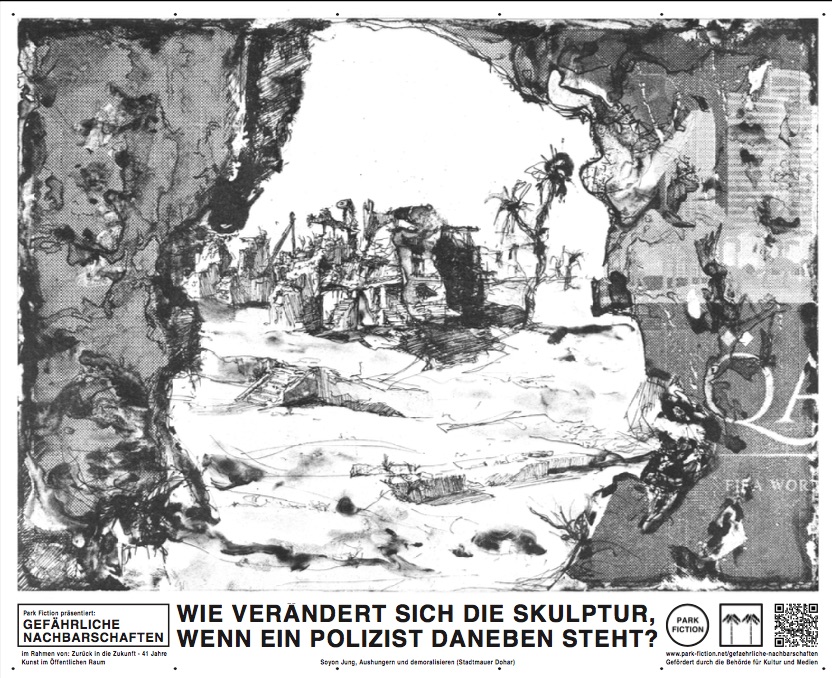
7
Soyon Jung’s etching from the series „Starving and Demoralising“ addresses the leading question of the exhibition and the broader question of social exclusions and demarcations indirectly and dystopically. The historical function of city walls experiences a revival in a future imagined by her, because future metropolises apparently want to protect themselves against rebellious rural populations.
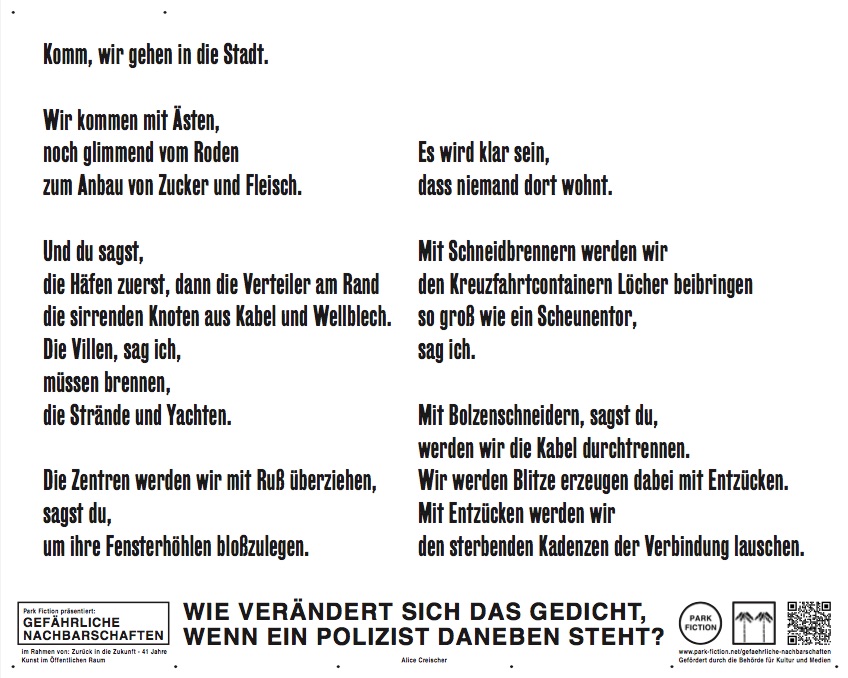
7
Artist Alice Creischer has sent us a poem that oscillates between dystopia and revenge fantasy, looking at the closing promises of freedom of the harbour and seafaring, and the chains that the connecting cables have turned out to be.
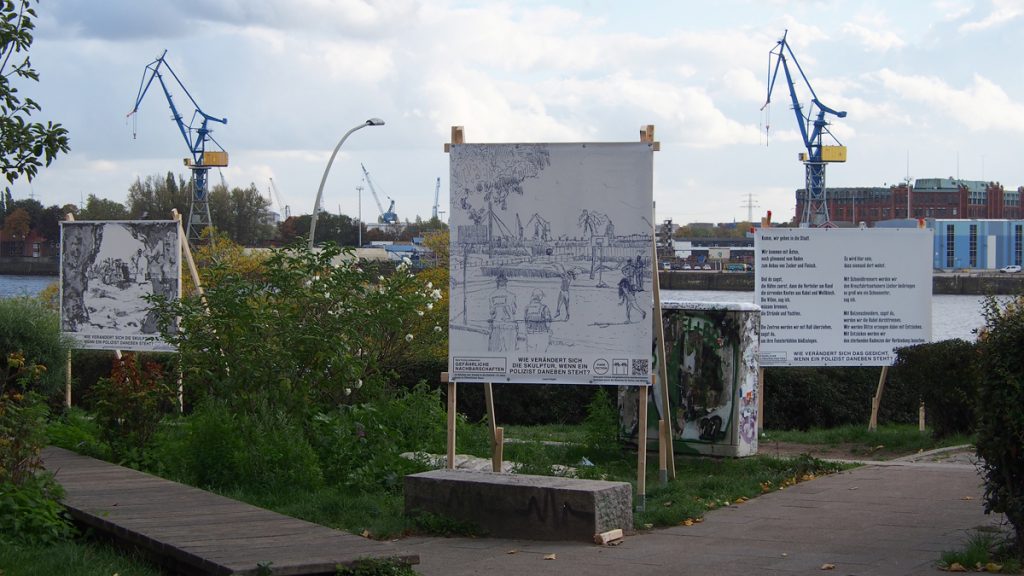
7
Artist Laura Ziegler draws herself and a friend playing basketball under police surveillance in Park Fiction and leaves it up to the viewer to decide what to make of it.

8
The Hamburg painter Nabila Malalai Attar has developed a very special way of bringing objects into the surface of the pictorial space. In this way, she gives the figures a fundamental calm, despite all their narrative content, and the bodies of the police officers a soft, intrusive menace in a surveillance situation on the basketball court in Park Fiction.
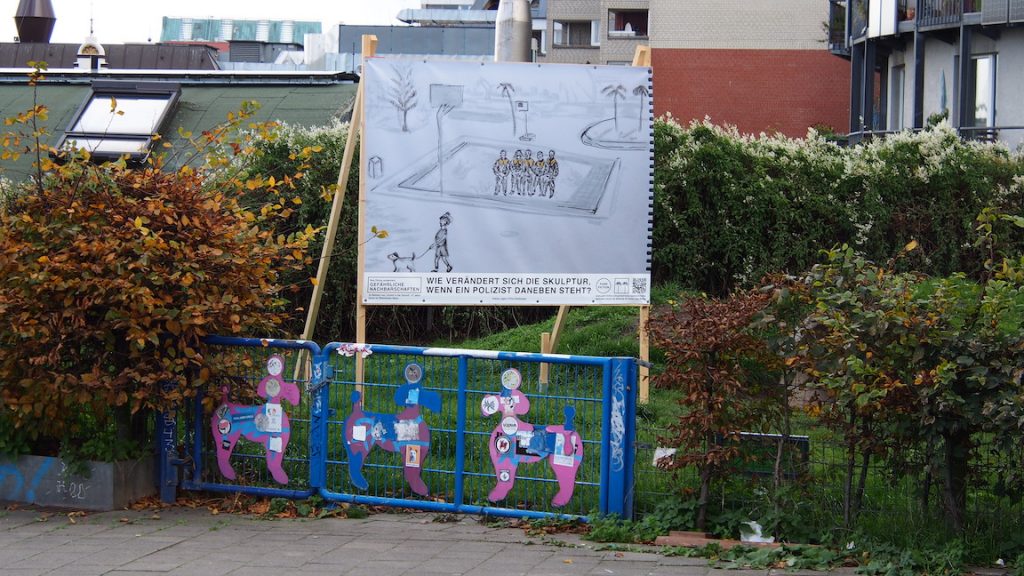
9
Pina Distelmeyer and Sidney Logan, draw an absurd account of a neighbour who was followed by five pairs of police eyes while walking her dog during the lock-down at Park Fiction.
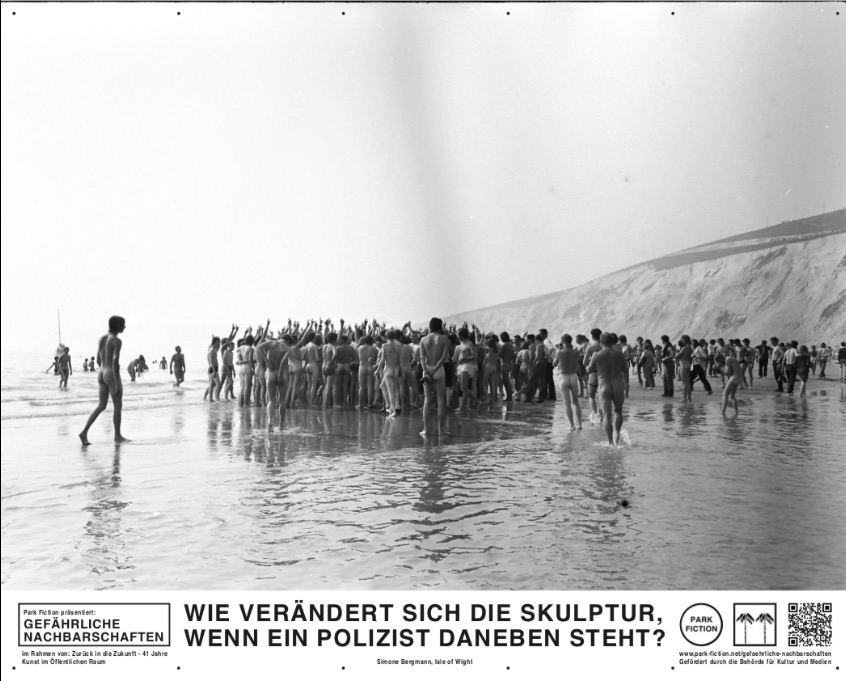
10
The tour ends with a utopian look back to the future:
In the barren expanse of the concrete surface, Simone Bergmann shows scenes on the beach of the Isle of Wight, on the fringes of the famous 1968 festival. A huge crowd of people converges on a vanishing point in the shallow water as if magnetically drawn to it. The scene seems like an origin scene of assembly, of the unchallenging coming together that has been at the origin of almost all democratic movements of the last 12 years – from the Arab Spring to #occupywallstreet, from the Spanish plaza occupations to Gezi. But even after the restrictions and distance of the Corona years, Bergmann’s images develop an almost beguiling seductiveness.
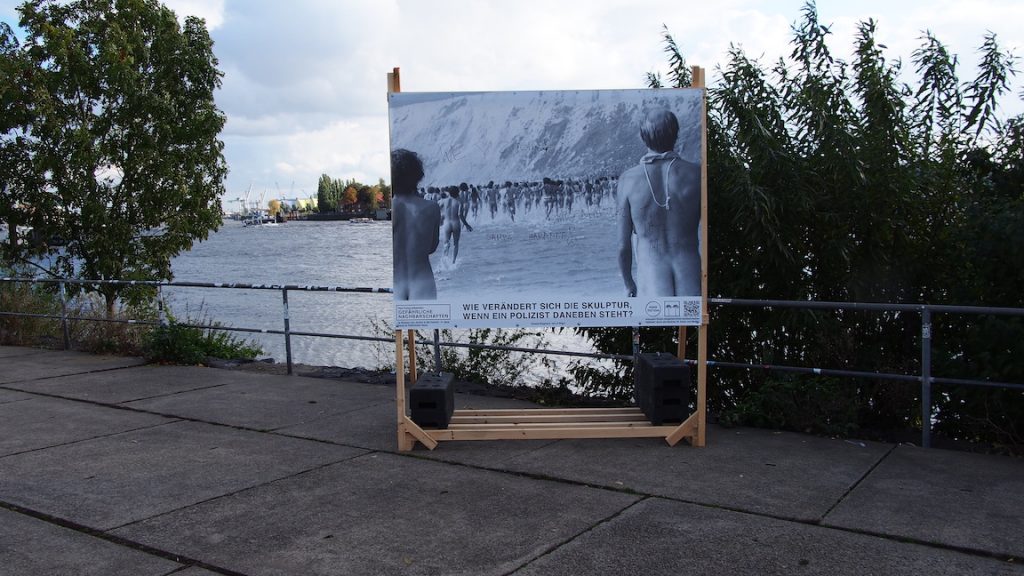
Background:
Since its foundation in 1995, and not least since its participation in documenta 11 in 2002, Park Fiction has been regarded as an art project that intervenes in reality as part of a fabric of social and political initiatives. The project has done pioneering work especially in the democratisation of urban planning.
When the results of this collective wish-production, namely the park with the iconic palm trees, were opened in 2005, the neighbouring site was declared a „danger area“ and thus the entire population was put under V erdacht.
While Park Fiction democratically opened up the planning process, at the same time fundamental rights were massively restricted and police powers expanded. Especially for black people and people of colour, this has resulted in constant racist controls and arbitrary detentions.
Although the „danger zone“ was declared unconstitutional by the courts in 2015, it reappeared shortly afterwards under a new name, as a „dangerous place“. Since then, a so-called „Task Force Drugs“ has also been on the streets of St. Pauli.
So what the Hamburg CDU (impressed by the successes of the right-wing populist Schill) had started is still continuing today.
Artist Laura Ziegler, herself represented with a work in the exhibition, says: „One of the most tolerant neighbourhoods in Germany has become the testing ground for a dense police patrol.“
The exhibition takes place within the framework of „Back to the Future – 41 Years of Art in Public Space“, initiated by the Hamburg Authority for Culture and Media. Especially after the restrictions of the Corona period, we think it is important to use public space again as a place of discourse and criticism.
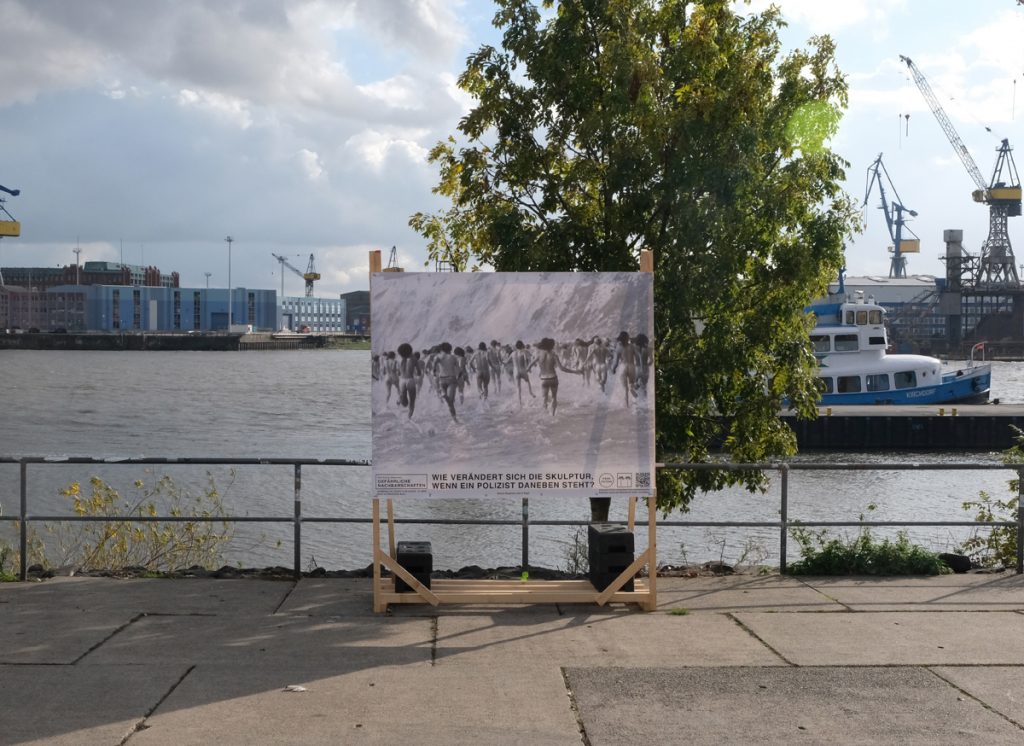
Exhibition tour in English language:
Sunday 6 November, 3pm from Arrivati Park.
